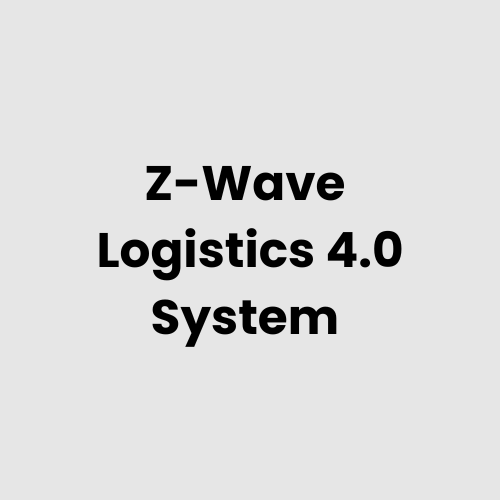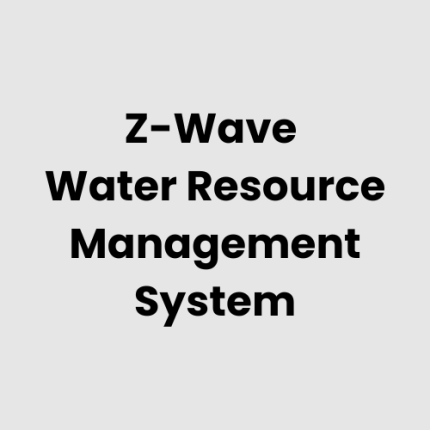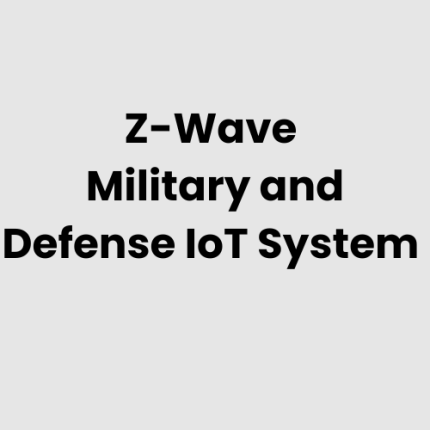Description
Technical Architecture of Z-Wave Enabled Logistics 4.0 System
The Z-Wave Enabled Logistics 4.0 system utilizes a robust IoT architecture that integrates smart sensors, actuators, and gateways into a cloud-connected network. Z-Wave-enabled devices monitor warehouse conditions, track shipments, and automate processes. The architecture includes local servers for edge processing, cloud-based analytics for advanced data insights, and secure APIs for integration with existing enterprise resource planning (ERP) and supply chain management (SCM) systems.
List of Hardware of Z-Wave Enabled Logistics 4.0 System
- Z-Wave Sensors: For temperature, humidity, motion, and light monitoring.
- Z-Wave Gateways: To connect local networks to cloud platforms.
- Z-Wave-enabled Smart Tags: For shipment tracking and inventory management.
- Smart Actuators: To automate conveyor belts and robotic arms.
- Security Cameras: Integrated with Z-Wave for real-time monitoring.
- Digital Displays and Kiosks: For warehouse and fleet updates.
- Power Supply Units: UPS for uninterrupted operation.
Physical Placement Considerations
- Warehouses: Sensors should be placed at strategic points such as entrances, storage racks, and climate-sensitive zones.
- Transport Vehicles: Smart tags and GPS trackers should be attached to cargo for real-time tracking.
- Gateways: Positioned centrally to ensure maximum range and connectivity within the facility.
- Actuators: Installed near automation points like conveyor systems or dock doors.
- Security Cameras: Mounted at entry/exit points and critical storage areas.
Hardware Architecture of Z-Wave Enabled Logistics 4.0 System
The hardware architecture comprises a decentralized network of Z-Wave devices connected through repeaters to extend coverage in large warehouses. Gateways aggregate data from sensors and transmit it to local servers or the cloud. Actuators and automation devices receive control commands from the system, enabling real-time responses to operational changes.
Deployment Considerations
- Network Scalability: Plan for future expansions of Z-Wave devices without overloading the network.
- Data Security: Implement encryption and access control for all Z-Wave communications.
- Compatibility: Ensure seamless integration with existing ERP and SCM systems.
- Testing: Conduct thorough pre-deployment tests to verify device compatibility and connectivity in the facility.
- Maintenance: Establish regular maintenance schedules for hardware and software.
List of Relevant Industry Standards and Regulations
- ISO 28000
- ISO/IEC 27001
- GS1 Standards
- ANSI/TIA-568
- NIST Cybersecurity Framework
- GDPR (General Data Protection Regulation)
- C-TPAT (Customs-Trade Partnership Against Terrorism)
Local Server Version
For operations requiring on-site data processing, Z-Wave Enabled Logistics 4.0 can run on a local server. This configuration supports edge computing, enabling real-time decision-making with minimal latency. Local servers ensure continuous operations even during network outages, enhancing reliability for critical logistics tasks.
Cloud Integration and Data Management
Z-Wave Enabled Logistics 4.0 integrates seamlessly with leading cloud platforms to enable advanced analytics and remote monitoring. Data from Z-Wave devices is securely transmitted to the cloud for processing, storage, and visualization. Cloud integration also allows real-time collaboration between different facilities and stakeholders. GAO Tek’s expert support ensures a smooth transition to this hybrid architecture, optimizing performance and security.
GAO Tek Inc., headquartered in New York City and Toronto, delivers industry-leading IoT solutions tailored to Logistics 4.0. Our decades of expertise and commitment to quality empower businesses to modernize their supply chains with confidence.
GAO Case Studies
USA
- Chicago, Illinois
A leading logistics hub implemented Z-Wave-enabled smart tags and sensors to monitor warehouse inventory in real-time. The system optimized storage allocation and reduced order-picking errors, improving overall efficiency. - Dallas, Texas
A distribution center in Dallas deployed Z-Wave sensors to track environmental conditions like temperature and humidity, ensuring compliance with perishable goods standards. - Atlanta, Georgia
In Atlanta, a logistics company integrated Z-Wave-enabled gateways and smart actuators to automate conveyor systems, reducing downtime during peak operational hours. - Los Angeles, California
A freight forwarding company enhanced security by installing Z-Wave security cameras and motion detectors at its Los Angeles warehouse, providing 24/7 remote monitoring. - Memphis, Tennessee
A major logistics hub used Z-Wave devices to streamline vehicle loading operations, with real-time data shared through a cloud-integrated dashboard, improving vehicle turnaround times. - Seattle, Washington
A Seattle-based e-commerce fulfillment center adopted Z-Wave-enabled systems for inventory tracking and order processing, cutting delivery times significantly. - Miami, Florida
A cold storage facility in Miami utilized Z-Wave technology to monitor refrigeration units, ensuring consistent temperatures and preventing spoilage of sensitive products. - Newark, New Jersey
A port logistics operator integrated Z-Wave-enabled sensors to monitor container movement, improving tracking accuracy and reducing misplaced shipments. - Houston, Texas
In Houston, Z-Wave automation tools streamlined pallet sorting and automated forklift operations, significantly improving productivity in a high-volume distribution center. - Denver, Colorado
A logistics firm in Denver used Z-Wave technology to track and optimize fleet operations, incorporating real-time GPS and vehicle diagnostics. - Cincinnati, Ohio
A warehouse in Cincinnati implemented Z-Wave smart lighting solutions to reduce energy consumption, integrating them with motion sensors for operational efficiency. - Phoenix, Arizona
In Phoenix, a fulfillment center deployed Z-Wave environmental sensors to ensure optimal air quality, safeguarding both workers and stored goods. - Portland, Oregon
- Portland’s logistics provider incorporated Z-Wave-enabled smart locks and access control systems, enhancing security across multiple storage facilities.
- Charlotte, North Carolina
A logistics company in Charlotte integrated Z-Wave-enabled robotics for automated material handling, enhancing speed and precision in operations. - Kansas City, Missouri
In Kansas City, Z-Wave tracking systems were installed on outbound shipments, enabling real-time monitoring and improved customer satisfaction.
Canada
- Toronto, Ontario
A Toronto-based logistics company leveraged Z-Wave devices for end-to-end supply chain visibility, integrating real-time data from storage to transportation. - Vancouver, British Columbia
In Vancouver, a warehousing service employed Z-Wave-enabled sensors and actuators to automate inventory management, achieving notable time and cost savings.
GAO Tek Inc., headquartered in New York City and Toronto, delivers Z-Wave-enabled solutions that transform logistics operations. Our commitment to innovation and quality ensures robust support for businesses aiming to achieve operational excellence.
Navigation Menu for Z-Wave
- Z- Wave Gateways/Hubs
- Z-Wave End Devices
- Z-Wave-Cloud, Server, PC& Mobile System
- Z-Wave Accessories
- Z-Wave Resources
Navigation Menu for IoT
- LORAWAN
- ZIGBEE
- Wi-Fi HaLow
- Z-WAVE
- BLE & RFID
- NB-IOT
- CELLULAR IOT
- GPS IOT
- IOT SENSORS
- EDGE COMPUTING
- IOT SYSTEMS
Our products are in stock and can be shipped anywhere in the continental U.S. or Canada from our local warehouse. For any further information, please fill out this form or email us.
We are actively looking for partners who are like us located in the U.S. and Canada. For more information on partnering with GAO, please visit Partner with GAO Tek Inc. It lists various ways to partner with GAO, such as OEM Partnerships, Technology Integration, Distribution and Reselling Opportunities, Presenting at the Leading Event Tek Summit, Joint R&D Projects, Training and Consulting Services, Industry-Specific Collaborations, Research and Academic Partnerships.



